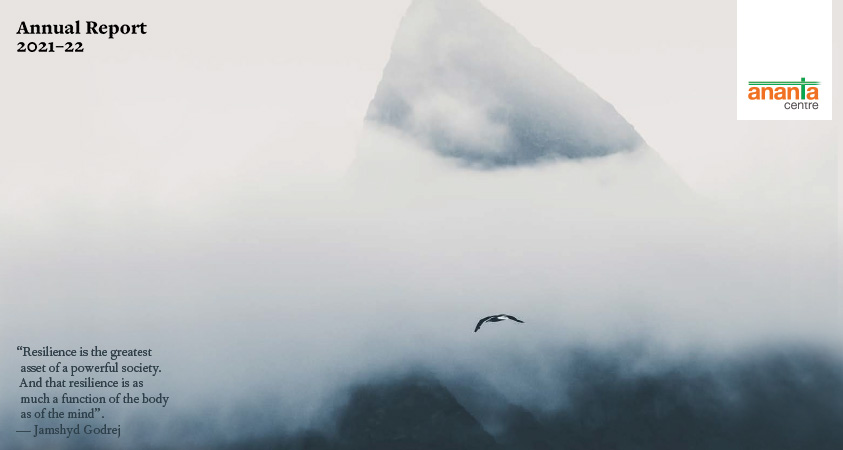Govt confident on growth prospects despite global headwinds The latest economic review, released by the government in the third week of October, exudes confidence about the Indian economy’s performance in the current year, even while it underlines the challenges posed by weather uncertainties and global headwinds like “adverse geopolitical turns and volatile crude oil prices”. It notes with some satisfaction that the International Monetary Fund (IMF) has revised India’s growth projection for 2023-24 by 20 basis points to 6.3 per cent. However, the IMF’s projection for global growth remains unchanged at 3 per cent. This is being interpreted by the government as a sign of the world recognising India’s “economic strength amidst global uncertainties and fresh geopolitical challenges”. Three key factors have been identified as positive forces behind India’s economic growth prospects. These are strong private consumption demand, a gradual strengthening of investment demand and a pick-up in the pace of industrial activity as seen in the recent data on industrial production and perception surveys. Investment so far in post-Covid years has been supported largely by capital expenditure by the Union government, which has begun crowding in private corporate investment. At the same time, the demand for residential properties has seen a rise, supported by a healthy increase in housing loan financing. Consequently, the construction sector and the real estate markets have shown improvements. Also helping the economy, according to the government, is the robust nature of “macroeconomic concomitants of growth”, namely the easing of inflationary pressures, a downward movement in the core inflation and strong fiscal position of the Union government with steady revenue growth, prudent rationalisation of revenue expenditure and reining in the borrowing programme within the budgeted level. Employment trends have improved, with the unemployment rate declining and the overall labour force participation rate going up, although there are areas of concern over the sharp rise in self-employed people along with a decline in salaried employees. On the external front, the current account balance and foreign exchange reserves appear under control, according to the government. The review also draws strength from the Reserve Bank of India’s surveys that are optimistic about demand conditions, employment situation and industrial output. Growth prospects, therefore, are positive for 2023-24. Little impact of Covid on income-tax paying individuals Individual income-tax payers might not have suffered a big jolt to their earnings in 2020-21, the first year when the Covid pandemic devasted the Indian economy which contracted by over six per cent. In other words, the economic devastation caused by the pandemic was more harsh for people in the unorganised sector outside the direct taxes net. The latest tax collections data, released by the Central Board of Direct Taxes, shows that the number of taxpayers earning a gross annual income of over Rs 1 crore rose from 1.24 lakh in 2019-20 to 1.32 lakh in 2020-21. Of course, this increase was a little lower than what was witnessed in the previous six years, when the number of individuals earning gross income of over Rs 1 crore rose from 48,416 in 2013-14 to 1,24,063 in 2019-20. The number of individuals in most income-earning categories rose in 2020-21, with the number of tax returns going up to 63.69 million, compared to 60.23 million in 2019-20. Perhaps the income-tax data for 2021-22 will shed more light on the phenomenon of how Covid impact income levels among taxpaying individuals. Laptop imports come under a system of import authorization The new regime for imports of laptops and other specified information-technology (IT) hardware is now finally in place to take effect from November 1, 2023. What will now govern imports of such products would not be as restrictive as originally envisaged. But this will be only a partial relief for global laptop sellers. The restrictions have only been diluted and effectively the import regime for these products have become tighter. In August, the government had announced that all imports of laptops and specified IT hardware would be brought under the “restricted” category of import items as part of its efforts to ensure a trusted supply chain and reduce the country’s dependence on imports of such items from China. But the move was opposed by industry and consumers, with the government being accused of having revived licence raj. A day later the implementation of the decision was deferred till November 1. In 2022-23, India imported such products valued at over $8.7 billion, of which China’s share was as high as $5.1 billion or about 59 per cent. After several rounds of consultation with importing companies, the government has decided to introduce from November a new “contactless” import authorization system for such products. Under the new system, import permits would be issued in an “end-to-end” online format, clearing import requests as quickly as in 10 minutes. Importers would be allowed to apply for multiple authorization, following which they would obtain Customs clearance. The government plan, it appears, is to study the data to be collected through the import authorization system. Subsequently, it would take a view on how the import regime should be modified in the months to come. The import authorization scheme would remain valid till September 2024. The operation of this scheme could encourage many laptop manufacturers to start domestic facilities to assemble or manufacture these products in India, after taking advantage of the Production Linked Incentive or PLI scheme. India Inc set to raise its capital expenditure India Inc’s capital expenditure plans appear set to see a sustained recovery in the current year. According to a study, prepared by rating company, Care Ratings, the capacity utilisation level for Indian companies has now crossed the critical level of 75 per cent, indicating that, helped as they will be by improved profit, their capital investment will see a healthy rise to over Rs 8.6 lakh crore in 2022-23. Drawing on data from about 1,300 non-financial companies, the study has noted that 2022-23 saw their capital investment cross, for the first time, the pre-Covid level of Rs 8.3 lakh crore in 2018-19. The years of 2019-20 and 2020-21 witnessed their capex go down further to Rs 7.8 lakh crore and Rs 5.1 lakh crore, respectively. The recovery began in 2021-22, when capex by them rose to Rs 6.3 lakh crore. But the big increase – of about 36 per cent – took place in 2022-23. The fact that the capex increase rode on investments in petroleum, telecom, power, steel and retail sectors, accounting for over half of the total investment, augurs well for the pace of economic activity in the current year. Muted topline and robust profit growth for India Inc The divergence in the performance of Indian companies in the July-September 2023 quarter is troubling to many analysts. A common sample of about 330 companies, which have so far declared their results for the second quarter of the 2023-24 financial year, have recorded a 36 per cent jump in their net profit, compared to 11 per cent in the same quarter of 2022-23. But their topline or sales performance has grown by only 10 per cent, compared to 24 per cent a year ago in the same period. This divergence is marked in the results of companies in the manufacturing and non-financial service sectors. Banks and other financial companies have continued to grow both their topline and bottomline. With sales growth remaining muted, there are serious doubts over the sustainability of the corporate sector’s performance with respect to its bottomline. Benefits for farmers through higher minimum support price The minimum support price (MSP) for wheat to be procured during the April-March period of 2024-25 has been raised by 7.1 per cent to Rs 2,275 per quintal – the highest increase announced by the Narendra Modi government since its formation in May 2014. The rabi marketing season for wheat normally starts from April. The move should cheer wheat-growing farmers, particularly those in the North and which account for the largest share in wheat production in India. The decision is not without its electoral significance. At least two of the north-Indian states, growing wheat for the Rabi marketing season, will have Assembly elections in December – Madhya Pradesh and Rajasthan. And the next general elections are due to be held in May 2024. A study of the extent of MSP increases for wheat during the Modi regime reveals two interesting trends. One, the MSP increase was just about 2 per cent in at least two years when the Covid pandemic had scarred the country. Two, the extent of MSP increases tends to go up in the years before the election season. Thus, the price announced for the 2017-18 and 2018-19 season saw an increase of 6.6 per cent 6.8 per cent, respectively, while the previous couple of years saw lower increases ranging from 3.6 per cent to 5.2 per cent. Similarly, the increases for 2023-24 and 2024-25 are for 5.5 per cent and 7.1 per cent, respectively. Higher MSP for wheat for the forthcoming Rabi marketing season also indicates that the government plans to mount an aggressive procurement campaign in the coming months to replenish the food grain stocks, which had declined to lower levels, though not going below the norms stipulated for buffer stocks. Another important crop, whose MSP rose by over 7 per cent, was masoor, a popular pulse variety. Almost one million tonnes of masoor are imported, mostly from Canada, to meet the country’s total demand, estimated at about 2.2-2.4 million tonnes. Note that Madhya Pradesh, going to polls in December, accounts for a large share of domestic output of masoor, estimated at around 1.2-1.4 million tonnes. Govt employees get higher allowances before Assembly polls An increase in the dearness allowance for employees and pensioners of the central government, announced on October 18, will cost the exchequer an additional spend of Rs 12,857 crore. But its electoral impact, coming as it does before the five Assembly elections, will not be insignificant. An estimated 4.86 million employees and another 6.79 million pensioners would benefit from the additional allowance, to be paid with effect from July 2023. In addition, about 1.1 million non-gazetted staffers of the Indian Railways would get a productivity-linked bonus, equivalent to 78 days of wages. The announcement was made in recognition of the Indian Railway loading a record cargo of 1.5 billion tonnes and carrying over 6.5 billion passengers in 2022-23. The pay-out would require the Indian Railways to spend an additional Rs 1,969 crore. The previous issues of Indian Economy Review are available here: LINK Supported by |
























